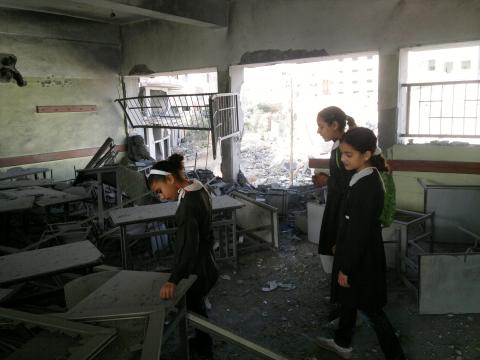Rising from the rubble: Palestinian students in Gaza return to school

Author: Sameeha Elwan, freelance writer with WV JWG
She gripped my hand to show me the way to her classroom. There were three walls in the classroom. The fourth wall was missing, completely destroyed leaving the room with street view. The other building was totally leveled. The air permeated with the smell of powder, dust and rubble. Pointing at what was supposed to be her classroom, Lina said, “This is my classroom. I mean, this was my classroom.”
Dressed in her green primary school uniform, and holding on to her backpack, Lina, a 9-year-old primary student returned to school, in Tal El-Hawa in Gaza City. She assumed that she was to resume her school life normally after the eight-day aggression on the Gaza Strip which claimed the lives of 163 Pelestinians, 34 of whom were children: 274 additional children were wounded a a result of the attacks. However, she could hardly even recognize her school.
Two days after the Egyptian-brokered cease-fire, tens of thousands of school children headed back to school in Gaza. Lina was one of these children who headed to class although she could hardly even recognize her school,
“It wasn’t as I expected,” she explained. “It was worse. Nothing is left. I was told that I have to leave school to be transferred to another one.”
For children trying returning to a life of normalcy after witnessing what they call “the war” is a challenge. Confused memories of this aggression bring about images of a similar offensive experienced four years ago during Operation Cast Lead in late 2008 and early 2009.
Lina lost her brother in the violence four years ago and for her (and many other children) this recent experience is connected to other situations. “I’m happy that I am fine and my family are in good health,” she says. “None of us were killed this time. Not like the last war when I lost my 17-year-old brother,” she remembers.
Lina didn’t hesitate to say she was terribly frightened during those eight days. Her family did not have anywhere to properly take shelter, so her father asked them to gather in a room downstairs which he thought was safe.
Other students, like 10-year-old Nour, were trying to conceal the fear by replacing it with feelings of defiance and determination to go back to school despite the destruction. “My classroom is totally destroyed. There are no chairs, no windows, no tables, no blackboard. Nothing, but we will go to another school until we rebuild our school again,” says Nour.
Nour’s defiant spirit and hard shell are likely the result of normalizing targeted violence in their lives. “Some of the children experienced a similar situation four years ago when the school was also destroyed while they were inside its buildings,” says Amani, one of the teachers at the school. “The scenes are familiar, but children still need time and effort to recover.”
This is only one of hundreds of schools in the Gaza Strip which have to deal with internally traumatized children, some of whom have survived direct violence; others have overcome indirect violence. However, despite the obstacles facing the Palestinians’ access to education, students collected what was left of their notebooks, paintings, chairs, and desks to rebuild their school all over again.
World Vision has 2,411 registered children in its North Gaza Area Development Programme, with 7,061 direct beneficiaries and as many as 22,594 indirect beneficiaries. In its South Gaza Area Development Programme, World Vision has 4,536 registered children, 10,000 beneficiaries and over 50,000 indirect beneficiaries. World Vision works with communities in Gaza to bring back hope into lives of children and families who are suffering under the illegal Israeli military occupation. Working in the areas of livelihood, education, and child protection, World Vision seeks to help improve families’ livelihoods and ensure children are cared for and protected. World Vision seek to ensure that all children are cared for, protected and participating and help increase hope and vision for a brighter future.